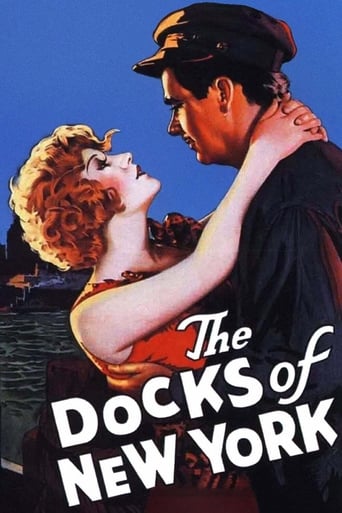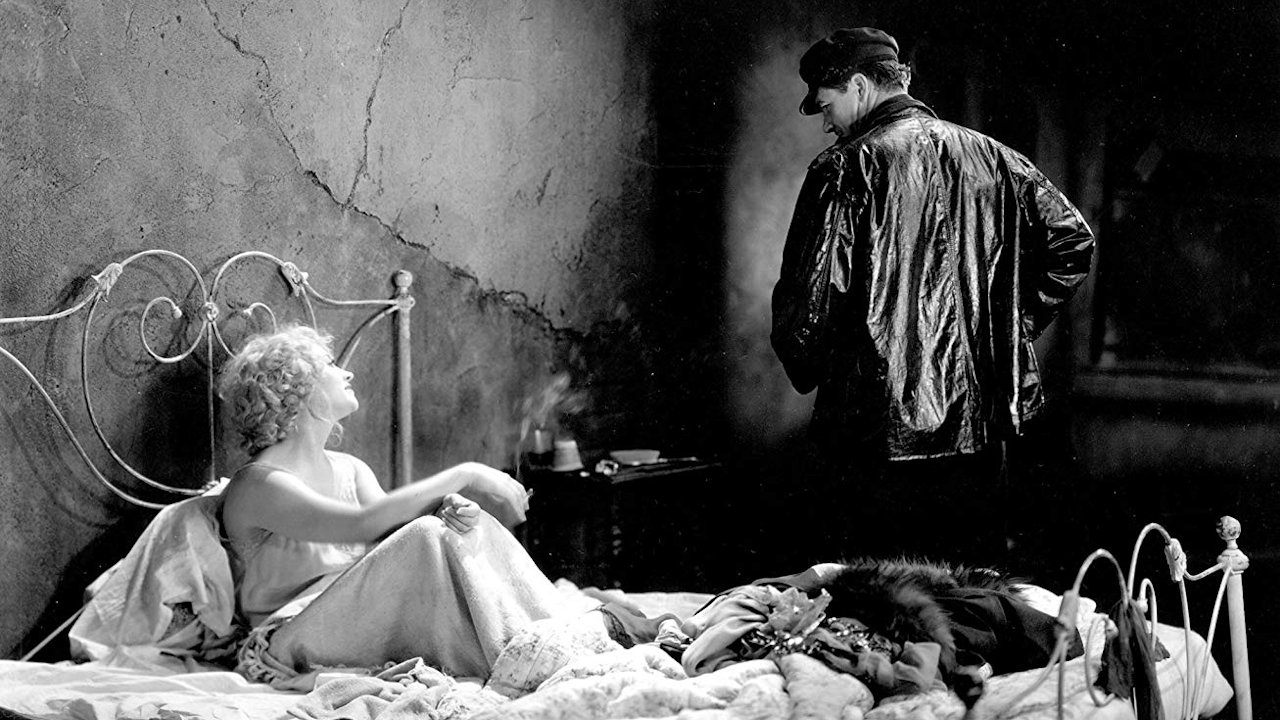chaos-rampant
Some of my most cherished impressions come from filmmakers who have this unique ability, as I have discovered, to paint a beautiful image with the notions that give rise to it built-in; it has to do with how a source outsources itself to itself and in that space creates a visible illusion, that is to say creates a living theater in which she is both author and player. Tarkovsky. Mizoguchi minus the melodrama. Storytelling in these cases is nothing more than our proxy in a world made of stories; something's got to be unfolding on that stage for us to be able to sift inside. Sternberg has given me one such film before this, so that alone ensures I will be always interested in what he had to say. But now and then in my journeys through these otherwise visionary makers I encounter a film like this; perfectly well-drawn, with a story finely crafted, fine acting, but I just don't know what to do with it.It's a straight romance between these two people who were never too good and never all bad, who made they choices they could. They are hurt or embittered, but sail through as best they can. Before they meet she has already given up and let sink.The story behind is more interesting; the woman is saved by him from death, and is thus given a new lease, a new life to be reborn into - he tells her her sins were all washed away in the slush - and she then turns for guidance to this man with the life-wisdom of sailing; who toils in the coalblack bowels of a ship, and now and then surfaces above for a night in the shared life. What he can teach her is this: life as the transient cycle of constant renewal, between anonymous work and small pleasure, between suffering and grace. The world shared between these two people is an incredibly rich construct, it suggests passage inside. The passage begins with a watery reflection suddenly rippled as the woman jumps into water. We don't see the action, the life going out of the world, only how it ripples across the surface. It's magic cinema.Unfortunately for me, Sternberg doesn't swim in these dim reflections. The rest of the film is written in crystal-clear waters. You can look down and see everything swimming where it's supposed to. Oh, it's perfectly fine as is, but it's all floating on the surface; the hidden streams and ebbs that move these people are forgotten in lieu of the more pressing but ultimately mundane social anxieties of the waking world.Is he going to stick with her, is he going to leave? More importantly, has she learned what was worth for him to leave behind?
Michael Neumann
Josef von Sternberg's visually romantic melodrama heralded the last gasp of classic silent film expression before the arrival of sound technology set the art of movie-making back 30 years. Moving from poetic realism to dramatic fantasy, the fairy tale plot follows a cruel, amoral ship's stoker who rescues a waterfront moll from attempting suicide. In a local tavern, after one drink and one fight too many, he casually decides to marry the girl, going through the motions in a farcical bar room wedding with no intention of honoring his vows. The scenario, characters, and themes of redemption are all well grounded in the particular moral and social climate of the late 1920s, but technically the film is equal to anything made since. Had it been produced just months later, it might have been little more than another novelty item from the primitive early sound era, instead of the artistic triumph it remains today.
Michael_Elliott
Docks of New York, The (1928) *** 1/2 (out of 4) Impressive melodrama benefits from some strong performances and some terrific visuals. The film tells the story of Bill Roberts (George Bancroft) a man who lives down on the docks who ends up saving a woman (Betty Compson) from killing herself. Over the period of a day he saves her life, then the two get to know one another before getting married hours later but neither of them know what the future might hold. The plot of this film is pretty simple and in many ways it's not too original but that doesn't hamper the film too much as director von Sternberg has such an amazing eye that each scene contains something fresh even if the story in that scene isn't anything new. I'm not sure how much a better story would have helped overall but it might have benefited in a few ways including the two actually falling for one another. In many ways this film plays out like a lonely males fantasy of him just happening to save a beautiful woman and then she gives him a chance of winning her heart. Being made years before the Code went into full effect allowed the director to show off some darker moments to both characters as it's made clear in a very funny scene that neither person are virgins and that they've both had their share of wild moments. What's most impressive about the direction here is his visual style, which is easily the most impressive that I've seen from him. Just take a look at the scene where Bill saves the woman. The fog is laid on very thick making the scene come off almost like a fantasy sequence and the way von Sternberg edits the thing makes it seem like some sort of strange dreamland. The way the girl is seen, pulled from the water and eventually carried home are all shot very darkly with very little light and what light there is comes mainly from the reflections off the fog. I loved the way von Sternberg shot the scene where the woman comes to and is introduced to the man who saved her. I loved where the camera was placed and how the lighting once again plays a very important part. The atmosphere is a very thick one as you can feel how dirty the docks are and all the people there seem like the type you'd actually find living and working there. Bancroft delivers a very good performance in a role he has no problem playing. The toughness of the character is very believable with Bancroft in the role but he also handles the more quiet and tender moments. Compson has the harder of the two roles as her character is much darker but she has no problem making us care for her. The two don't look like the types who would be together but their performances are so good and the two act so well together that they make us believe. While the film is far from flawless it's well worth watching for the performances and directing.
Steffi_P
One of the less obvious differences between sound and silent pictures, is that whereas in a sound picture the director will set up a scene, prep the actors and then call action, in a silent the director could (and usually would) continue to direct even while the cameras were rolling. Of course it's hard to tell how much this difference affected the finished product in real terms. However, with a director like Joseph "von" Sternberg, who demanded a complete (and indeed tyrannical) control over every aspect of the image, the ability to carry on shouting at his cast and crew right through the take was probably a considerable bonus in fine-tuning his elaborate visual style.With Docks of New York being a late silent, it has more or less as much fluidity of movement and camera angle as your average sound flick. However there is an extreme complexity in the movement of a kind that you only really saw in Sternberg's silents. Take for example those lengthy dolly shots through the bar, with extras moving across the shot as the camera goes in or out. Those movements across the screen look haphazard, but they are carefully timed to complement the camera movement and give a rising tide of franticness. To arrange everyone so precisely there must have been almost as much activity behind the camera as in front of it. You could do a shot like that in a talkie, but it would require copious reheasing, and I don't think that's something they tended to bother with in the early sound era, what with the all the other obstacles they had to overcome. It's certainly true that Sternberg used to spend most of his set-up time sorting out the lighting schemes, rather than giving any detailed priming to his cast.Sternberg's layered patterns of movement not only add to the aesthetic quality of this picture, but they enhance its atmosphere. The barroom scenes in particular have a spectacularly chaotic feel to them. The fact that every edge of the room is filled by a mass of moving bodies makes it impossible to figure out the size and layout of the place. But for all his visual lavishness, Sternberg himself admitted to caring little about stories, and as a result the narrative gets a little lost amidst all the shadows. This is even given the fact that Docks of New York is overburdened by intertitles.Sternberg had also yet to fully develop his stylised and dappled lighting patterns that can be seen in his talkies. Here that's a good thing, because it means his camera shows the actors up a little better. And there are some fine performances here worth capturing. George Bancroft gives a superbly realist turn, looking every inch the rough but basically good-hearted stoker. Betty Compson is also nicely subtle, in a slow and measured performance with plenty of under-the-surface emoting. An honourable mention should go to Clyde Cook, who plays Bancroft's buddy Steve. Cook was an Australian slapstick comic, once the star of his own shorts but by this time doing supporting work in features. He is perhaps a little too clownish for the sombre tone of Docks of New York, but entertaining to watch and capable of a spot of straight acting when the occasion demands.The oevre of Herr Sternberg can generally be summed up as pretty to look at but dramatically unengaging. As a silent picture, where the director can put his all into the image without having to worry about the business of dialogue, Docks of New York is just that little bit prettier to look at. And yet as one lacking in a strong narrative drive it is also that little bit more dramatically unengaging. It's a shame, because this is potentially one of the most poignant tales he ever dealt with. Bancroft and Compson recognise this, and play it appropriately, but the director remains a hard-boiled cynic who knows a few camera tricks.



 AD
AD


